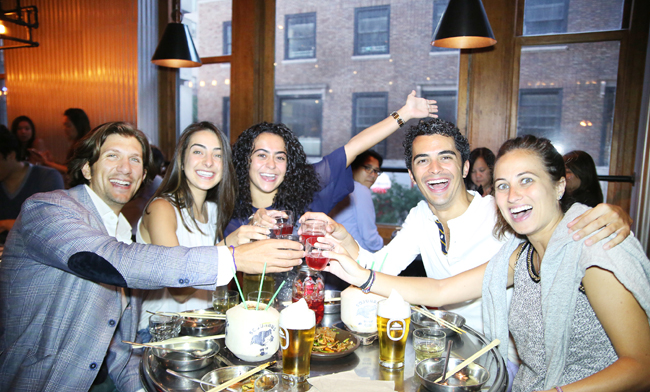- California Assembly OKs highest minimum wage in nation
- S. Korea unveils first graphic cigarette warnings
- US joins with South Korea, Japan in bid to deter North Korea
- LPGA golfer Chun In-gee finally back in action
- S. Korea won’t be top seed in final World Cup qualification round
- US men’s soccer misses 2nd straight Olympics
- US back on track in qualifying with 4-0 win over Guatemala
- High-intensity workout injuries spawn cottage industry
- CDC expands range of Zika mosquitoes into parts of Northeast
- Who knew? ‘The Walking Dead’ is helping families connect
The changing face of New York’s K-Town

A group of New Yorkers dine and drink inside Soju Haus in Manhattan’s Koreatown. (Chun Ji-hoon/Korea Times)
By The Korea Times New York staff
New York’s Koreatown, once a haven for Korean immigrants who set up shop in the 1970s and ’80s, has undergone a transformation into a city hotspot in the last five years.
Located along 32nd Street in Manhattan, K-Town has risen with South Korea’s booming cultural exports, from K-pop to K-dramas, K-beauty, K-food and K-fashion.
“Non-Korean customers interested in Korean food and Korean drinking culture began increasing three or four years ago,” said Moon Joon-ho, owner of Soju Haus and a Korean-style karaoke bar, MK Noraebang, in town. “Now they make up about 70 percent of our business.”
Until the early 2000s, K-Town was stomping grounds almost exclusively for generations of Korean Americans and international students.
Now, local storefronts — once littered with traditional Korean restaurants — are offering more for the widening audience in terms of Korean cultural experiences, from cafes and makeup stores to hip lounges and noraebangs.
Successful Korean franchises, among them Gyochon Chicken, The Face Shop, Tous Les Jours, Paris Baguette and Cafe Bene, have also taken notice of New York K-Town’s growing potential as a foreign Korean hub.
“New Yorkers who venture to K-Town are looking for modern interiors and a young atmosphere, not just traditional Korean fare,” said a local real estate representative. “They want to experience Korean culture, and that includes things like K-pop and K-beauty. This has become an era in which businesses that opened in the ’80s and ’90s cannot survive if they do not transform.”

















Pingback: Korean Restaurant In Koreatown | European Food News
Pingback: Best Restaurant Koreatown New York | usa - intresting restaurant
Pingback: Korean Restaurant In Nyc | Chefs Hat
Pingback: Best Korean Restaurant In Nyc Koreatown | Find a Restaurant
Pingback: Food Franchise In Korea | Basics - Start Franchising
Pingback: Korean Restaurant In Manhattan New York | Indian Restaurant Wiki
Pingback: Korean Restaurant In Bayside, New York | Eat Nearby
Pingback: Best Korean Restaurant In Nyc Koreatown | Your Local Restaurant Guide
Pingback: Korean Restaurant In Manhattan New York | Restaurant Wiki
Pingback: Paris Baguette New York Koreatown | The best parks in New York & news